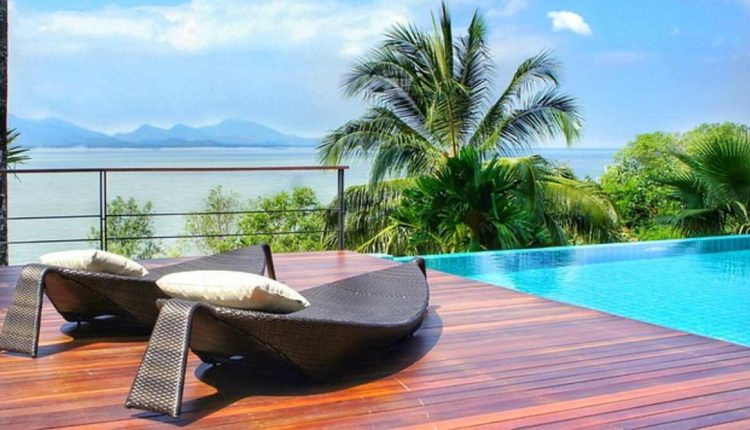When laying hardwood decking, the issue of “Does it matter which side faces up” invariably arises. The thing is, it does. The wood grain’s direction heavily influences the board’s future shape changes. Any material, including wood, will be put through its paces by the alternating cycles of wet and dry, hot and cold.
The grain of a piece of wood will naturally try to align itself. This means that as the moisture content of the wood changes, it will either form a “cup” shape or a “crown” shape, depending on the direction of the grain. The wood will swell or shrink as moisture enters or leaves it. The wood will probably undergo an unwanted shape change as a direct result.
Wood’s ability to change shape takes many shapes. Bow, crook, kink, cup, and twist are some of the more popular ones. Specifically, only “cup” is of any use in this write-up. Cupping, in which a two by 4 (or other board) develops a “cup” form across its cross-section, is a common problem with hardwood decking.
Cupping and crowning are two distinct but related techniques. Cupping is akin to smiling, whereas crowning is more akin to frowning. There’s been some back-and-forth over whether the option is worse, but I think you should decide once we’ve covered all the essential points. There are benefits and drawbacks, some of which are readily apparent and others that are more subtle.
Choose “quarter-sawn” boards if you have the luxury of being particular about the wood you use for decking and the money to spare. Boards that have been quarter-sawn have grain directions that are perpendicular to the board’s longer cross-sectional edge. Compared to their flat-sawn cousins, these boards are more expensive and far rarer.
Due to the orientation of the grain, quarter-sawn boards are far more durable than flat-sawn. Wood expands and contracts predominantly along the direction of the growth rings, so it’s easy to see why quarter-sawn boards would be more stable than flat-sawn ones. However, it may be difficult to locate enough quarter-sawn decking planks to construct a complete deck.
Cupping
The “smile-shaped” cup that develops in the wood when it is installed “bark-side up” is known as cupping. Due to the risk of splintering involved with “bark-side down,” also known as shelling (see below), this technique is favored by many experts. After weighing the benefits and drawbacks, I believe it comes down to priority and personal preference, but many experts prefer the “bark side down.”
Even excluding the unfavorable outcomes of shelling (caused by crowning), cupping has its own set of problems:
The sticking-out geometry poses a tripping hazard.
When the “cup” fills with water, it quickly rots.
While aesthetic judgments may vary, most agree that it looks terrible.
The strength of the cup determines how far the fasteners can be dragged through the board before they lose their grip. I don’t need to tell you that loose and “rocking” boards can lead to structural issues down the road. If the “see-saw” motion is strong enough, the board will eventually break because of the gradual loosening.
Turning a tree on its side causes it to cup because the sapwood, rather than the heartwood, is on the outside. The arrangement is not without its drawbacks. Sapwood is more porous than heartwood. Thus, it may take up decay-preventative treatments more effectively.
Shelling The fact that bark-side down (crowning) frequently results in shelling is perhaps the most crucial aspect in the dispute over whether the bark should be up or down. Let me elaborate. The growth rings of a tree consist primarily of earlywood and latewood. Earlywood is the wood that develops before the middle of the tree, or the heartwood.
The outer layer, known as latewood, develops in the final stages of the growing season. When the earlywood and latewood separate from one another due to recurrent wet and dry cycles, this process is known as shelling. Deterioration to the top surface, which can lead to decay and further deterioration (not to mention the painful implications of walking barefoot on such surfaces), results from splintering.
Crowning
It’s the opposite of cupping and gives the wood a “frown-shaped” appearance as it warps. Due to the risk of shelling, professionals typically advise against this deck installation method. Nonetheless, some types of wood are more susceptible to shelling than others. Some people believe that only particular types of softwoods, such as Southern yellow pine and Douglas fir, are suitable for shelling.
Now that we’ve covered the drawbacks of shelling, we can go on to the benefits of the ultimate type of warping:
When compared to cupping, it almost always appears better.
The area is safe and won’t cause any accidents due to tripping.
Fast drying time due to good water drainage.
There won’t be any “see-saw” action, but the central mound of the board will place some force on the fasteners. The fasteners will be pulled partially or entirely through the material if the wood is cupped or crowned. With crowning, the swaying “see-saw” action won’t add any further strains.
The board’s bark side-down orientation exposes the heartwood rather than the sapwood to the environment. You probably already know that heartwood is more resistant to rot and insects than sapwood, even though it also doesn’t absorb anti-rot treatments. This is the way to go if you don’t want to treat the boards.
There are advocates on all sides of this discussion, and the best decision may be made after considering all the evidence. There appear to be knowledgeable people arguing for both sides, and it’s difficult to discern which side is correct. However, I believe the bark-side-down position is preferable under the current circumstances.
Tips for Decking Installation on the Joists:
Always use two fasteners per joist when attaching two by 4s to the joists. You shouldn’t reduce the amount of fasteners unless necessary. The width of a two by 4 makes it impossible to use a single fastener. Higher humidity below the deck relative to above will cause the lower surface of the board to expand parallel to the grain, even if the bark-side-down installation method is used (growth rings in frown). The board may cup in either direction because of uneven drying and swelling. The degree of cupping can be drastically reduced by using two fasteners per joist instead of one.
Wide-headed fasteners are recommended for this purpose. When the wood tries to twist and turn, the amount of pull-through will be reduced.
Keep the head above the level of the board. If you do that, water and debris pool, accelerating the deterioration process. The two-by-four must be securely fastened to the joist so that extra torque is not required to pull the two components against each other. It’s tempting to tighten the board against the joist by squeezing the fastener a few millimeters past the surface, but doing so will lead to issues in the long run. If you’re using more complicated wood, the 24 may “float” if you don’t tap out a hole first, even if the screw head is flat with the surface.
Please check out my Free and Handy website if you enjoyed this article.
Read also: Customized Gaming Laptops – 5 Things You Must Consider Whenever Building a Gaming Laptop.


